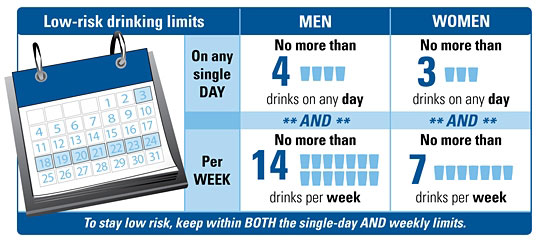
Not necessarily. Although they have fewer calories, many light beers have almost as much alcohol as regular beer—about 85% as much, or 4.2% versus 5.0% alcohol by volume, on average.
Check the alcohol content of your beverage. Malt beverages are not required to list their alcohol content on the labels, so you may need to visit the bottler's Web site.
A typical 25-ounce (750 ml) bottle of table wine holds about 5 "standard" drinks, each containing about 5 ounces. This serving size of wine contains about the same amount of alcohol as a 12-ounce regular beer or 1.5 ounces of 80-proof spirits.
Get to know what 5 ounces looks like by measuring it out at home. That way you can estimate how many standard drinks you're being served in a restaurant or bar that uses large glasses and generous serving sizes.
Mixing alcohol with certain medications can cause nausea, headaches, drowsiness, fainting, a loss of coordination, internal bleeding, heart problems, and difficulties in breathing. Alcohol can also make a medication less effective. For more information, see Harmful Interactions: Mixing Alcohol with Medicines.
Examples of medical conditions for which it's safest to avoid drinking include liver disease (such as from hepatitis C), bipolar disorder, abnormal heart rhythm, and chronic pain.
Among the dangers of underage drinking:
Even moderate amounts of alcohol can significantly impair driving performance and your ability to operate other machinery, whether or not you feel the effects of alcohol.
Heavy drinking during pregnancy can cause brain damage and other serious problems in the baby. Because it is not yet known whether any amount of alcohol is safe for a developing baby, women who are pregnant or may become pregnant should not drink.
About 50% of people who drink in this group have alcohol use disorder.
This "increased risk" category contains three different drinking pattern groups. Overall, nearly 20% of people who drink in this category have alcohol use disorder.
Only about 2% of drinkers in this group has alcohol use disorder.
A U.S. standard drink contains about 0.6 fluid ounces or 14 grams of pure alcohol (also known as an alcoholic drink-equivalent). That's the amount in 12 ounces of regular beer, 5 ounces of table wine, or 1.5 ounces of 80-proof distilled spirits.

Distilled spirits include vodka, whiskey, gin, rum, and tequila.
Light to moderate drinking
Heavy or at-risk drinking
Men: No more than 4 drinks on any day and no more than 14 per week
Women: No more than 3 drinks on any day and no more than 7 per week
People with a parent, grandparent, or other close relative with alcoholism have a higher risk for becoming dependent on alcohol. For many, it may be difficult to maintain low-risk drinking habits.
Pace yourself: It's best to have no more than one standard drink per hour, with nonalcoholic "drink spacers" between alcohol beverages. On any day, stay within low-risk levels of no more than 4 drinks for men or 3 for women. Note that it takes about 2 hours for the adult body to completely break down a single drink. Do not drive after drinking.
For comparison, regular beer is 5% alcohol by volume (alc/vol), table wine is about 12% alc/vol, and straight 80-proof distilled spirits is 40% alc/vol.
The percent alcohol by volume (alc/vol) for distilled spirits is listed on bottle labels and may be found online as well. It is half the "proof," such that 80-proof spirits is 40% alc/vol.
Enter in the proof of the alcohol in the left field to automatically calculate the alc/vol.
Enter in the measurement in milliliters in the left field to automatically calculate the amount in fluid ounces.